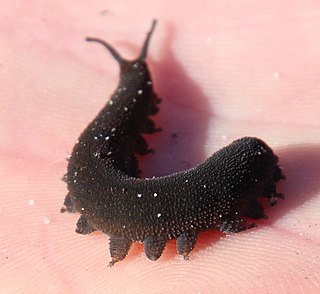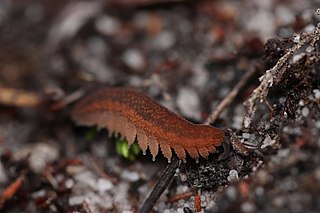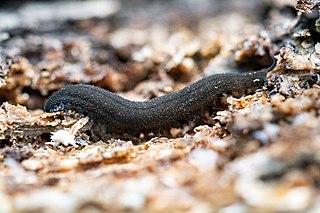Opisthopatus roseus is a species of velvet worm in the Peripatopsidae family. As traditionally defined, this species is rose pink with 18 pairs of legs. Known as the pink velvet worm, it is found only in the Weza Forest, a Mistbelt Forest in South Africa.
Opisthopatus is a genus of South African velvet worms in the family Peripatopsidae. The number of legs in this genus range from 16 pairs to 18 pairs. The feet in this genus feature three distal leg papillae: one anterior, one posterior, and one median. Mothers in this genus give birth to live young. In particular, this genus exhibits matrotrophic viviparity, that is, mothers in this genus retain eggs in their uteri and supply nourishment to their embryos, but without any placenta.

Peripatopsis is a genus of South African velvet worms in the Peripatopsidae family. The number of legs in this genus ranges from as few as 16 pairs to as many as 25 pairs and varies within species when the number is greater than 18 pairs. Velvet worms in this genus feature a last pair of legs that is rudimentary or reduced in size, mainly in males. The feet in this genus feature three distal leg papillae: two anterior and one posterior.

Peripatopsidae is one of the two living velvet worm families.
Opisthopatus cinctipes is a species of velvet worm in the Peripatopsidae family. This species has 16 pairs of legs, all with claws and all used for walking. The color of the dorsal surface varies from blue to olive green. Females range from 7 mm to 50 mm in length, whereas males range from 6 mm to 36 mm. Like other velvet worms in this genus, this species exhibits matrotrophic viviparity, that is, mothers in this genus retain eggs in their uteri and supply nourishment to their embryos, but without any placenta. The type locality is in South Africa.
Opisthopatus drakensbergi is a species of velvet worms in the family Peripatopsidae. This species is a clade in the O. cinctipes species complex. This species has 16 pairs of legs. Specimens are brown and slate black with a line down the middle of the back and a brown ventral surface. The original description of this species is based on a male holotype measuring 13 mm in length. This species is found at high altitude in the forests of the Drakensberg mountains in KwaZulu-Natal province in South Africa.
Opisthopatus laevis is a species of velvet worm in the Peripatopsidae family. This species has 16 pairs of legs. The type locality is in South Africa. The validity of this species is uncertain: Some authorities consider O. laevis invalid even as a subspecies of O. cinctipes, a similar species also found in South Africa, but other authorities recognize O. laevis as a separate species, citing the significant distance (570 km) between the type localities of these two species.
Opisthopatus natalensis is a species of velvet worm in the Peripatopsidae family. This species has 16 pairs of legs. The type locality is in South Africa. The validity of this species is uncertain: Although some authorities have deemed O. natalensis to be a subspecies of O. cinctipes, a similar species also found in South Africa, and others regard O. natalensis as invalid even as a subspecies, still other authorities recognize O. natalensis as a separate species, citing the significant distance between the type localities of these two species.
Cephalofovea tomahmontis is a species of velvet worm in the Peripatopsidae family. This species is ovoviviparous, has 15 pairs of oncopods (legs), and lives in rotting logs and leaf litter. The type locality is Mount Tomah, New South Wales, Australia, after which this species is named. Like all members of the genus Cephalofovea, both sexes of C. tomahmontis have a furrow on the head, between the antennae, which the male everts to carry his spermatophore to the female.
Paraperipatus novaebritanniae is a species of velvet worm in the Peripatopsidae family. This species is black with brown-yellow spots. Females of this species have 24 pairs of legs; males have 22 or 23 leg pairs. Females range from 14 mm to 55 mm in length, whereas males range from 14 mm to 26 mm. The type locality is in New Britain, Papua New Guinea.
Peripatopsis balfouri is a species of velvet worm in the Peripatopsidae family. This species has 18 pairs of clawed legs. Also known as the blue velvet worm, this species ranges from 9 mm to 22 mm in length. The type locality is in South Africa.

Peripatopsis capensis is a species of velvet worm in the Peripatopsidae family. This species has 18 pairs of legs: 17 pregenital leg pairs with claws plus one strongly reduced last pair without claws or spinous pads. Females of this species range from 9 mm to 70 mm in length, whereas males range from 6 mm to 54 mm. The native range of this species is limited to the Cape Peninsula of South Africa.
Peripatopsis intermedia is a species of velvet worm in the Peripatopsidae family. This species is about 33 mm long and has 19 pairs of legs: 18 pregenital leg pairs plus a last pair of much reduced legs. The type locality is in South Africa. Although some authorities doubt the validity of this species and deem it to be a junior synonym of P. balfouri, others consider these two to be separate species, citing the distance between their type localities.

Peripatopsis lawrencei is a species of velvet worm in the Peripatopsidae family. This species has 18 pairs of legs: 17 pregenital leg pairs plus one last pair that is strongly reduced and without claws or spinous pads. This species is restricted to the Theewaterskloof-Overstrand region of South Africa.

Peripatopsis moseleyi is a species of velvet worm in the Peripatopsidae family. Males of this species have 20 to 24 pairs of legs with claws ; females have 19 to 23 pairs of legs with claws. Females range from 11 mm to 75 mm in length, whereas males range from 9 mm to 50 mm. The type locality is in South Africa.
Peripatopsis sedgwicki is a species of velvet worm in the Peripatopsidae family. Also known as the Tsitsikamma velvet worm, this species has a narrow geographic distribution in South Africa but is especially abundant in the indigenous forest of the Tsitsikamma mountains. Recent phylogenetic analysis suggests that Peripatopsis sedgwicki is a species complex that contains three clades, each with a distinct geographic distribution, including at least one clade that may represent a novel species.

Peripatopsis overbergiensis, the Overberg velvet worm, is a species of velvet worm in the Peripatopsidae family. This species usually has 19 pairs of legs: 18 pregenital leg pairs plus one last pair that is strongly reduced and without claws or spinous pads. Some individuals, however, have only 18 leg pairs. This species is limited to the Overberg region of South Africa.

Peripatopsis alba, the white cave velvet worm, is a species of velvet worm in the family Peripatopsidae. This species is notable as one of only two species of velvet worm known to be troglobitic; the only other velvet worm known to be a troglobiont is Speleoperipatus spelaeus. The white cave velvet worm is rare and limited to one cave system on Table Mountain in South Africa.
Peripatopsis leonina, the Lion's Hill velvet worm, is a species of velvet worm in the Peripatopsidae family. This species has 20 to 24 pairs of legs, usually 21 or 22 leg pairs, with the last pair of legs reduced. Females of this species range from 7 mm to 41 mm in length, whereas males range from 7 mm to 34 mm.
Opisthopatus herbertorum is a species of velvet worm in the Peripatopsidae family. The type locality is in South Africa. As originally described, this species is uniformly white with 17 pairs of legs. Subsequent phylogenetic results, however, cast doubt on this species delimitation based on morphology, indicating instead that O. herbertorum is a junior synonym of O. roseus.






